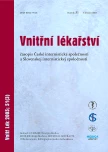Smoking habits of female and male doctors compared with smoking in the population of the Czech Republic. Comparison with the situation in the year 1991
Authors:
J. Widimský 1; Z. Škodová 2; T. Pecka 3
Authors‘ workplace:
Subkatedra kardiologie IPVZ, Praha, ředitel MUDr. Antonín Malina, Ph. D., Klinika kardiologie IKEM, Praha, přednosta doc. MUDr. Jan Kautzner, CSc., FESC
1; Pracoviště preventivní kardiologie IKEM, Praha, přednosta doc. MUDr. Renata Cífková, CSc.
2; NOVARTIS, Praha
3
Published in:
Vnitř Lék 2005; 51(3): 286-290
Category:
Original Contributions
Overview
In the year 1992 we published the analysis of smoking habits of female and male doctors comparing the occurrence of smoking with the situation in the Czech population of corresponding age monitored within the study MONICA. The aim of this presentation is the analysis of the situation in the year 2003 and its comparison with the situation 12 years ago. Anonymous questionnaire survey was performed in the year 2003 on the occasion of training proceedings given by the Institute for further education of health care professionals (IPVZ). We analysed answers from 470 informants. The principal finding of our study 12 years ago was the fact that the occurrence of smoking among doctors is high, though significantly lower than in the common population of corresponding age (24% vs 42%). On the contrary it was found that female doctors smoke just as frequently as female population of corresponding age (27% vs 25%). The situation was substantially improved after 12 years. Smoking habits were significantly decreased both among male and female doctors. Furthermore both male and female doctors smoke significantly less than population – 16% versus 36% (p < 0.001) nowadays. The decrease of smoking habits was pronounced both among male and female doctors and sex difference in smoking habits doesn’t exist any more. Male and female doctors smoke significantly less frequently than Czech population (sample of corresponding age from the study MONICA), even though smoking habits of male population of corresponding age were decreased. Smoking occurs in 16.0% of male doctors comparing to 36.2% of the sample of male population of corresponding age nowadays; at present 16.2% of female doctors smoke in comparison with 25.8% of the sample of female population of corresponding age. But still the number of smokers among male and female doctors is higher than in USA, Great Britain and Scandinavian states, where the percentage of smokers among male and female doctors ranges between 3–8%. There is still something left to be improved.
Key words:
development of smoking habits – male doctors – female doctors
Sources
1. Bartecchi CE, MacKenzie TD, Schrier RW. The human cost of tobacco use. N Engl J Med 1994; 330: 907–912.
2. Králíková E, Kozák JT. Odvykání kouření v denní praxi lékaře. Praha: Maxdorf 1997.
3. Unal B, Crichley JA, Capewell S. Explaining the decline in coronary heart disease mortality in England and Wales between 1981 and 2000. Circulation 2004, v tisku.
4. Widimský J, Skibová J, Škodová J et al. Kuřácké návyky lékařů a lékařek v České republice. Vnitř Lék 1992; 38: 1208–1214.
5. Jamrozik K. ABC of smoking cessation. Policy priorities for tobacco control. Br Med J 2004; 328: 1007–1009.
6. Škodová Z, Cífková R, Adámková V et al. Dlouhodobý vývoj a současný stav kuřáckých zvyklostí obyvatelstva České republiky. Cor Vasa 2002; 44: 812–816.
Labels
Diabetology Endocrinology Internal medicineArticle was published in
Internal Medicine

2005 Issue 3
Most read in this issue
- Hyperphosphataemia as an important complication of chronic renal insufficiency and chronic renal failure, part 1 – etiopathogenesis, consequences and diagnostics
- Hyperphosphataemia as an important complication of chronic renal insufficiency and chronic renal failure, part 2 – treatment
- Novel findings on iron metabolism
- Anticipated costs on treatment of diabetes mellitus and its late complications in CR – preliminary study
